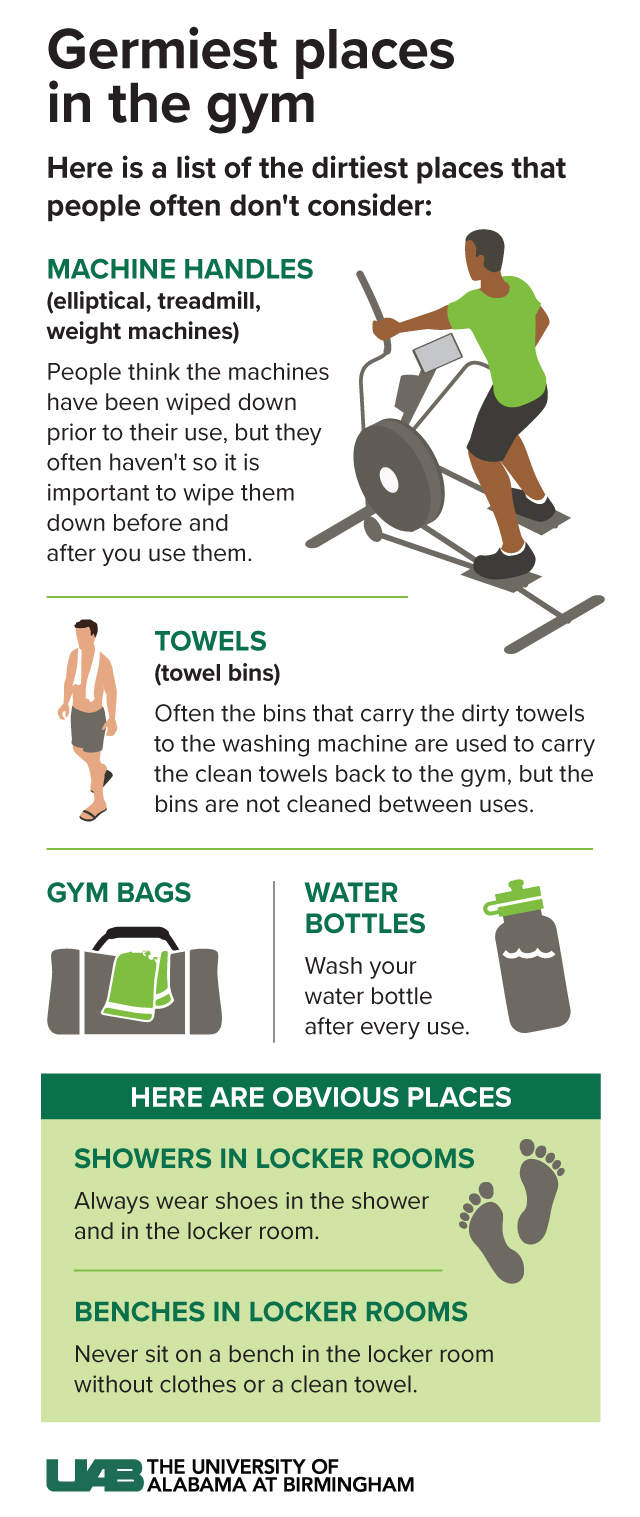 During the colder months, many exercise routines transition indoors, especially in gyms. However, the gym may be one of the dirtiest places you walk into. Numerous studies have shown that gyms can be covered in cold and flu viruses, as well as E. coli, MRSA and other bacteria and virus strains that can make you sick.
During the colder months, many exercise routines transition indoors, especially in gyms. However, the gym may be one of the dirtiest places you walk into. Numerous studies have shown that gyms can be covered in cold and flu viruses, as well as E. coli, MRSA and other bacteria and virus strains that can make you sick.
Bryan Combs, CRNP, a nurse practitioner at the University of Alabama at Birmingham School of Nursing breaks down the dirtiest places in the gym and how to get fit without getting sick.
Dirtiest places in the gym
“The biggest thing about the gym is there are a lot of areas where germs, viruses and fungus can be year-round,” Combs explained.
Here are the top places:
Handlebars
The worst places are handlebars on ellipticals, treadmills, stationary bicycles and weight machines.
“Even if the handlebars are cleaned regularly, handlebars are going to be covered in bacteria,” Combs said.
On top of that, many people assume the machines have been cleaned after each use, but that is often not the case. It is best to clean the machines on your own before and after each use.
“You need to use wipes or a disinfectant spray to wipe down the machines or weights before and after. Once you clean the equipment, hang your towel on an area that you know is clean. When you get done, clean it again for the next person.”
Towels
Something that people assume is clean are the towels that gym patrons grab when they walk into the facility.
“While the towels have been washed, a lot of gyms use the same container to carry dirty towels to the washing area and then use the same one to bring clean towels back, so they can become contaminated again.”
Combs recommends bringing your own clean towel to make sure you avoid contamination with the germs from dirty towels. It is important to always wash your towel after each workout, too.
Water bottles
While using reusable water bottles is recommended and good for the environment, it is important to always wash them after every use.
“Some people use the same water bottle each time they go to the gym. If you don’t take it home and wash it, and you go to the gym a few or several days a week, the water bottle could be covered in bacteria.”
Combs says soap and hot water are the best ways to wash the bottles after each visit to the gym.
Gym bags
Gym bags are often the most overlooked items and often carry the most bacteria.
“A lot of times we take our dirty clothes and put them in there, but we never clean the bag when we are done.”
To prevent the spread of germs, it is important to always spray the bags with a disinfectant spray to kill the bacteria. This is recommended after each use if possible, but at least a few times a week for frequent gym-goers.
 Showers and locker rooms
Showers and locker rooms
Always, always wear shoes in all areas of the gym, but especially in locker rooms and in the shower. If you sit down, make sure a clean towel is placed on top of the bench or seat.
“Walking barefoot in locker rooms or showers is an easy way to contract MRSA or pick up a fungal infection like athlete’s foot. By wearing clean shoes, you can prevent catching something that is spread by skin contact.”
It is also important to change your clothes after each work out.
“As soon as you leave the gym, you should change clothes as soon as possible. A lot of people continue to wear their sweaty clothes for an hour or hour and a half. It’s important to take those off and shower as soon as you can after a workout.”
While most people know that door handles, bathroom knobs and faucets are contaminated, it is important to use paper towels to turn off faucets and open the door after washing your hands.
Combs says by following the above tips, you can help ensure that you are protecting your immune system while also maintaining a health lifestyle.